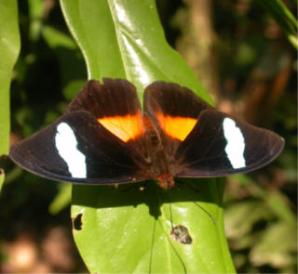
|
Bolivia
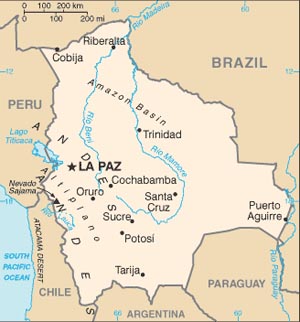
Introduction The Democratic Republic of Bolivia has a population of about 10 million of mixed races including Amerindians, Mestizos, European, Asians and Africans. The main language is Spanish but there 37 languages, including Quechuan languages which are recognized. This has given the country a wide cultural diversity, reflected in many fields. It is landlocked by five other south American countries. In Hispanic times, it had been part of Peru but eventually gained independence in 1825. It is divided into 9 departments. Economically it is regarded as a developing country with main activities in mining, forestry, agriculture. It has a manufacturing base in textiles and clothing, but also refined metals especially tin. |
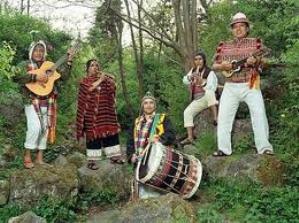 |
|
|
Geography The country has several different climates. In the west the Cordillera Oriental of the Andes dominates and encloses the Bolivian Altiplano, one of the largest high altitude plateaux in the world. This area also includes Lake Titicaca on the border with Peru and the highest fresh water lake in the world. There are lush fertile valleys descending eastwards down to the lowlands in the east. The main areas here are the Amazonian rainforests stretching towards Brazil, and the Chaco Plain covering the low plains towards Paraguay. It is self-evident that there is an enormous diversity of climate over this altitude variation. |
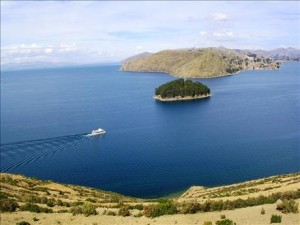 |
|
Economy Bolivia struggled to diversify its economy for many years due to instability and lack of infrastructure and political will. However over the last 25 years the government has made great strides in controlling inflation and encouraging growth and alleviating poverty. They have allowed public sector organizations to be partially privatized to stimulate efficiency and investment. Bolivia has one of the largest natural gas reserves in South America and private investment enabled the construction of a pipeline to Brazil who now buy substantial amounts. Mining has always been an important sector with tin, silver and now zinc being significant areas of activity, and the extraction industries, including hydrocarbons account for10% of GDP. Agriculture makes up 15% GDP, with manufacturing at 17%. Main foreign trading partners are the USA and the Andean countries. |
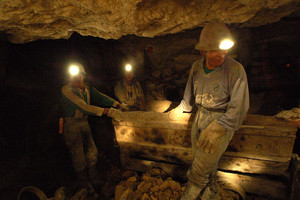 |
|
Government The current president is socialist Evo Morales who came to power in 2005. He is the first indigenous Aymaran Indian to be elected as head of the country and dedicated to the redistribution of wealth and poverty reduction. Originally a farmer himself, he understands the plight of the country`s poor and has the demographic political advantage of having the support of the majority of the indigenous population. He has moved to nationalize most of the oil and gas reserves, which has proved a popular policy for the masses, but alarmed the wealthy conservative middle classes. His moves towards giving greater control and autonomy to the poor majority secured him a re-election in 2009. |
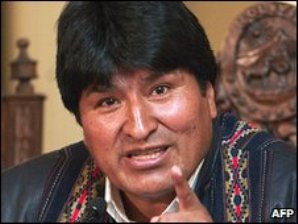 |
|
Santo Cruz Santa Cruz de la Sierra is the largest city in Bolivia with a population of around 2 million mixed ethnic groups. It was founded in 1561 by the Spanish along with other Europeans and Guarani natives. The city has a tropical savanna climate with a warm average temperature of 23 degrees. In recent years, economic growth has generated reasonable wealth in the city which now accounts for over 30% of the national GDP. Its heritage is still very much preserved in its present day culture and traditions. Its cuisine has a rich mix of native vegetables like yucca, squash, corn and peanuts, with foods brought in by the Spanish like rice, poultry, beef and citrus fruits. The local Spanish language is known as `Cambañol` where `s` is pronounced like a `j`, and `voseo` is used in place of the informal `tu` pronoun. Santa Cruz also produces a large number of winners of the country`s beauty contests, and is regarded as an important centre for modeling and fashion. |
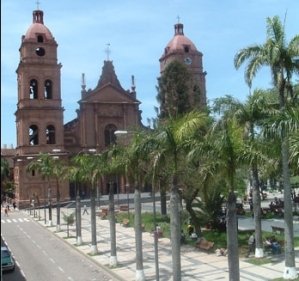 |
10 Other interesting facts about Bolivia 1. Bolivia has the world`s largest butterfly sanctuary. 2. The country has the largest salt deposit in the world. 3.Like many south american countries, soccer is the most popular sport. 4. The Bolivian motto `La union es la fuerza` means `unity is strength`. 5.Bolivia has annual rainfall over 5metres! making the country one of the wettest in the world. 6.One of the main exports is soybeans. 7. 78% of the population is Roman Catholic resulting from the Spanish heritage. 8. The main meal of the day is lunch which usually includes soup with a main dish. The staple food is potato served with most meals. 9. Humitas are a favourite food made with fresh corn and cheese wrapped in corn leaves and steamed. There are several different recipes. 10. A traditional favourite drink is Chicha which is made from homemaed fermented corn. It used to be drunk by the Incas! |
|
|
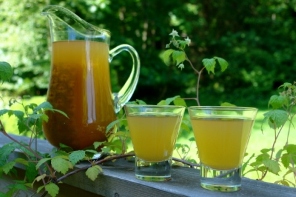 |
Other neighbours of Bolivia Visit the premier SBI! website on Bolivia |
